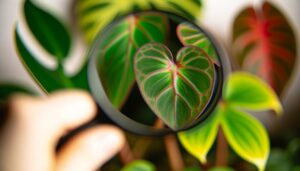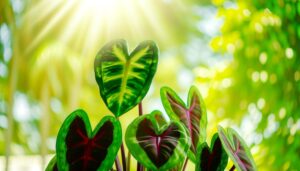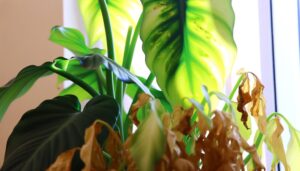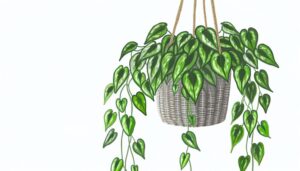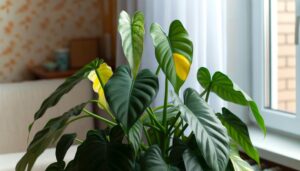What Is a Philodendron Yellow Congo?
Philodendron Yellow Congo is a tropical hybrid from the rainforests of South America, classified under the Araceae family. It features vivid, lemon-yellow foliage with a glossy texture and robust, upright stems.
This plant thrives in bright, indirect light and can adapt to lower light conditions. It requires well-draining soil composed of peat moss, perlite, pine bark, and compost to prevent root rot, and prefers stable temperatures between 18°C and 27°C along with 60%-80% humidity.
Regular bi-monthly fertilization is essential during the growing season to avoid nutrient deficiencies. Continue to learn about common issues and care techniques.
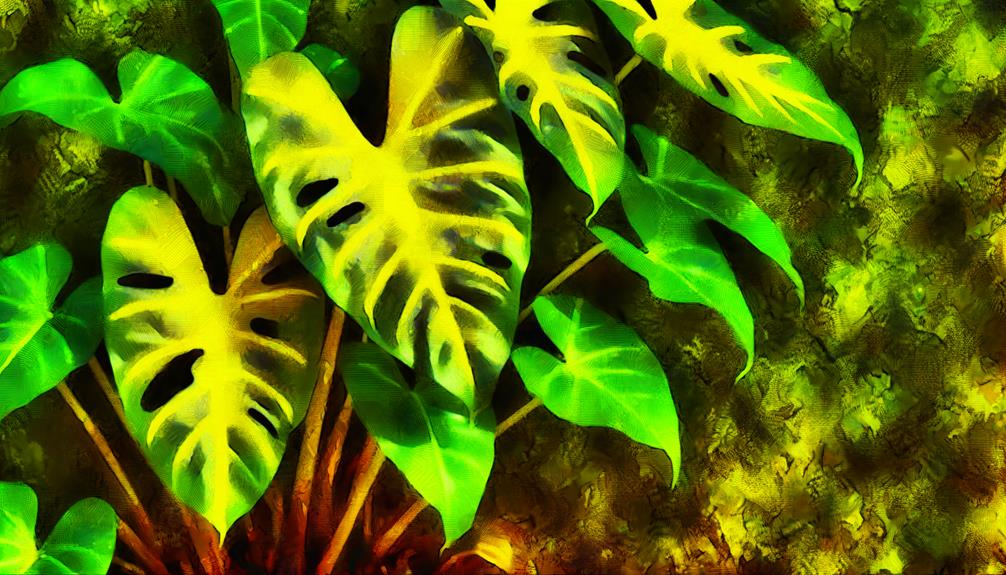
Key Takeaways
- Philodendron Yellow Congo is a tropical plant hybrid from South America's rainforests.
- It features vibrant lemon-yellow, glossy leaves and sturdy stems.
- It thrives in bright, indirect light but tolerates lower light conditions.
- Requires well-draining soil and careful watering to avoid root rot.
- Ideal temperature range is 18°C to 27°C with high humidity levels.
Origins

The Philodendron Yellow Congo, scientifically known as Philodendron 'Congo Rojo', is a tropical plant hybrid that originates from the dense rainforests of South America. This region, characterized by high humidity and consistent rainfall, provides an excellent environment for the growth of such robust and adaptive flora.
The plant belongs to the Araceae family, which encompasses a wide array of aroids known for their striking foliage and ease of cultivation. The hybridization process involves the selective breeding of various Philodendron species to enhance specific traits, such as vibrant coloration and increased hardiness.
These genetic modifications have resulted in a plant that not only retains the resilience and adaptability of its parent species but also exhibits unique and desirable characteristics suited for both indoor and outdoor cultivation.
Appearance
Characterized by its striking lemon-yellow foliage, Philodendron 'Congo Rojo' showcases large, glossy leaves that can reach lengths of up to 45 centimeters, providing an eye-catching display in any botanical collection. These leaves exhibit a robust, elliptical shape with a smooth texture, making them a standout feature.
Key characteristics include:
- Leaf Color: The foliage exhibits a vibrant lemon-yellow hue that adds a splash of brightness to interior spaces.
- Leaf Size: Mature leaves can attain lengths of up to 45 cm, contributing to the plant's dramatic appearance.
- Glossy Texture: The leaves have a shiny, waxy surface, enhancing their aesthetic appeal.
- Stem Structure: Thick, sturdy stems support the foliage, ensuring the plant maintains an upright posture.
These attributes make Philodendron 'Congo Rojo' a distinctive member of any plant collection.
Growth Pattern
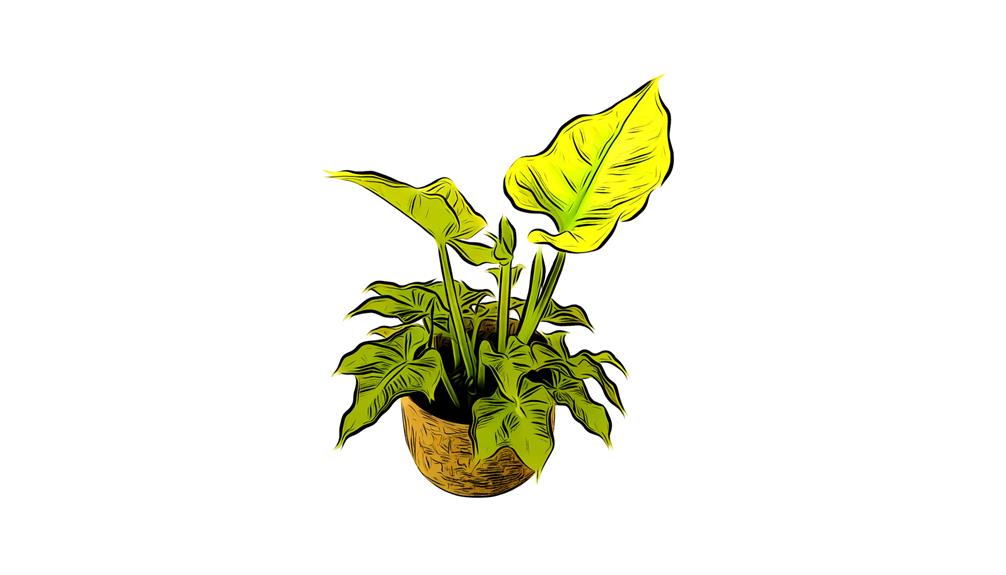
Philodendron 'Congo Rojo' displays an upright growth pattern, characterized by a robust and compact habit that supports its large, glossy leaves. This growth architecture allows for a dense clustering of foliage, optimizing photosynthesis.
The plant's stems, or petioles, are thick and sturdy, ensuring structural integrity and stability. Each leaf emerges from a central point, giving the plant a symmetrical and balanced appearance. The internodal spacing is relatively short, contributing to the compact form.
Concerning the root system, Philodendron 'Congo Rojo' develops a well-established network of both aerial and terrestrial roots, enhancing nutrient uptake and anchorage. This growth form is advantageous for container cultivation, making it a popular choice for both residential and commercial interiorscapes.
Light Requirements
Philodendron 'Yellow Congo' thrives best in bright, indirect light, which mimics the dappled sunlight of its native understory habitat.
Direct sunlight should be avoided as it can scorch the foliage, causing chlorosis and necrosis.
Importantly, this cultivar demonstrates a significant adaptability to lower light conditions, maintaining its vibrant yellow-green pigmentation even in shaded environments.
Ideal Lighting Conditions
Promoting ideal growth for Philodendron 'Yellow Congo' involves understanding its preference for bright, indirect light, which mirrors the dappled sunlight of its native tropical habitat. This species, Philodendron hederaceum, thrives in environments where light intensity measures between 10,000 to 20,000 lux.
Key considerations for prime lighting include:
- Light Duration: Aim for 10-14 hours of light per day, utilizing natural or artificial sources.
- Light Quality: Full-spectrum bulbs replicating natural sunlight are preferred if relying on artificial light.
- Light Placement: Position the plant 3-5 feet away from a north or east-facing window.
- Seasonal Adjustments: Increase light exposure during winter months to compensate for reduced natural light.
This approach promotes robust photosynthesis, fostering vibrant foliage and overall plant health.
Avoid Direct Sunlight
Direct sunlight exposure can cause photodamage to the delicate leaves of Philodendron hederaceum 'Yellow Congo', leading to chlorosis and scorched foliage. Chlorosis, characterized by the yellowing of leaf tissue due to insufficient chlorophyll, compromises the plant's photosynthetic efficiency.
Scorched foliage, manifested as brown, crispy leaf edges, results from the thermal stress and excessive ultraviolet radiation inherent in direct sunlight. The best growth of Philodendron hederaceum 'Yellow Congo' necessitates the mitigation of photoinhibition and heat stress.
It is essential to position the plant in environments with filtered light or indirect sunlight. Ensuring proper light conditions will maintain the plant's vivid yellow-green foliage and overall health. Appropriate light management is vital for sustaining the aesthetic and physiological integrity of this ornamental species.
Adaptability to Shade
Adaptability in low light conditions is a defining feature of Philodendron hederaceum 'Yellow Congo', enabling it to thrive even in suboptimal lighting environments. This flexibility is particularly advantageous for indoor cultivation, where natural light may be limited.
The plant's chlorophyll-rich leaves optimize photosynthesis in shaded areas, guaranteeing robust growth. To maximize the health and vibrancy of Philodendron hederaceum 'Yellow Congo', consider the following light requirements:
- Indirect Light: Ideal for maintaining leaf coloration and overall plant well-being.
- Partial Shade: Acceptable for slower growth but prevents leaf burn.
- Artificial Light: Fluorescent or LED lights can supplement natural light.
- Avoid Direct Sunlight: Direct sun can cause leaf scorching and color fading.
Understanding these requirements guarantees successful cultivation in various lighting conditions.
Watering Needs

Philodendron 'Yellow Congo' requires a specific watering regimen to maintain best growth. Typically, it needs irrigation when the top 2-3 cm of soil have dried. Overwatering can lead to root rot, characterized by yellowing leaves and a mushy root system. Monitoring soil moisture levels and observing plant responses are essential for maintaining its health.
Optimal Watering Frequency
Maintaining ideal watering frequency for Philodendron 'Yellow Congo' (Philodendron hederaceum var. oxycardium) requires understanding its specific soil moisture needs, which typically involve keeping a consistently moist but not waterlogged substrate. The following guidelines can help achieve this balance:
- Soil Moisture Check: Use a moisture meter or insert your finger 2-3 inches into the soil to assess moisture levels. Water when the topsoil feels arid.
- Watering Schedule: Usually, watering once a week suffices, adjusting frequency based on indoor humidity and temperature.
- Water Quality: Use distilled or rainwater to avoid mineral build-up, ensuring prime plant health.
- Drainage: Ensure the pot has sufficient drainage holes to prevent water accumulation, which can lead to root rot.
These practices will help maintain prime soil moisture for the Philodendron 'Yellow Congo'.
Signs of Overwatering
Excessive moisture in the substrate can lead to several detrimental conditions, most importantly root rot, characterized by wilting leaves, yellowing foliage, and a general decline in plant vigor. Root rot, primarily caused by waterlogged soil, reduces oxygen availability to the roots of Philodendron 'Yellow Congo' (Philodendron hederaceum).
Symptoms include chlorosis, where leaves turn pale or yellow due to insufficient chlorophyll, and necrosis, marked by brown, dead tissue. The plant may exhibit stunted growth and a weakened structural integrity. Overwatering also promotes fungal pathogens such as Pythium and Phytophthora, exacerbating root decay. A foul odor emanating from the root zone signifies advanced decay.
Ensuring proper drainage and allowing soil to dry between waterings are critical preventive measures.
Soil Preferences
For best growth, Philodendron 'Yellow Congo' requires well-draining soil rich in organic matter to maintain the ideal balance of moisture and aeration. A suitable potting mix should include a combination of components that foster both drainage and nutrient retention.
Here are key soil components:
- Peat Moss (Sphagnum): Enhances moisture retention while providing organic content.
- Perlite (Volcanic Glass): Improves aeration and prevents soil compaction.
- Pine Bark (Pinus spp.): Adds texture and promotes drainage.
- Compost (Humus): Supplies essential nutrients and microbial activity.
This specific blend guarantees the substrate remains neither too waterlogged nor too dry, which is vital for the plant's root health (rhizosphere).
Proper soil composition is essential for the prevention of root rot (Phytophthora spp.) and other soil-borne diseases.
Temperature Tolerance
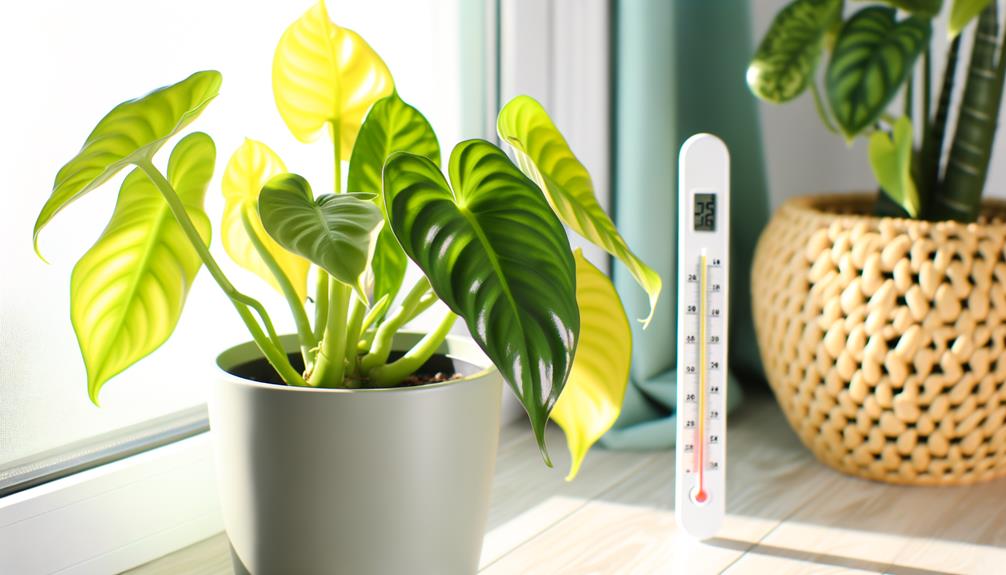
Philodendron 'Yellow Congo' flourishes in temperatures ranging from 18°C to 27°C, showcasing excellent growth within this specific thermal window. This temperature range closely imitates the plant's native tropical habitat, guaranteeing optimal physiological processes.
Exposure to temperatures below 15°C can induce cold stress, leading to slowed growth and leaf discoloration. Conversely, prolonged temperatures above 30°C may trigger heat stress, causing wilting and impaired photosynthesis.
The plant's cellular structure and metabolic functions are finely tuned to moderate thermal conditions, highlighting the significance of maintaining a stable environment. Maintaining ambient conditions within the specified range is essential for sustaining the Philodendron 'Yellow Congo's' vibrant foliage and overall plant health, ensuring both aesthetic appeal and biological importance.
Humidity Levels
Maintaining high humidity levels between 60% and 80% is important for the best growth and physiological functioning of Philodendron 'Yellow Congo'. Elevated humidity guarantees ideal stomatal conductance and transpiration rates, which are critical for nutrient uptake and overall plant health.
To achieve these conditions, consider the following recommendations:
- Use a Humidifier: Positioning a humidifier near the plant can consistently sustain the desired humidity range.
- Group Plants Together: Placing multiple plants in proximity can create a microenvironment with increased humidity.
- Pebble Trays: Setting the pot on a tray filled with water and pebbles can help enhance local humidity through evaporation.
- Regular Misting: Lightly misting the leaves will temporarily increase humidity levels, complementing other methods.
Maintaining these conditions will ensure the Philodendron 'Yellow Congo' thrives.
Fertilization
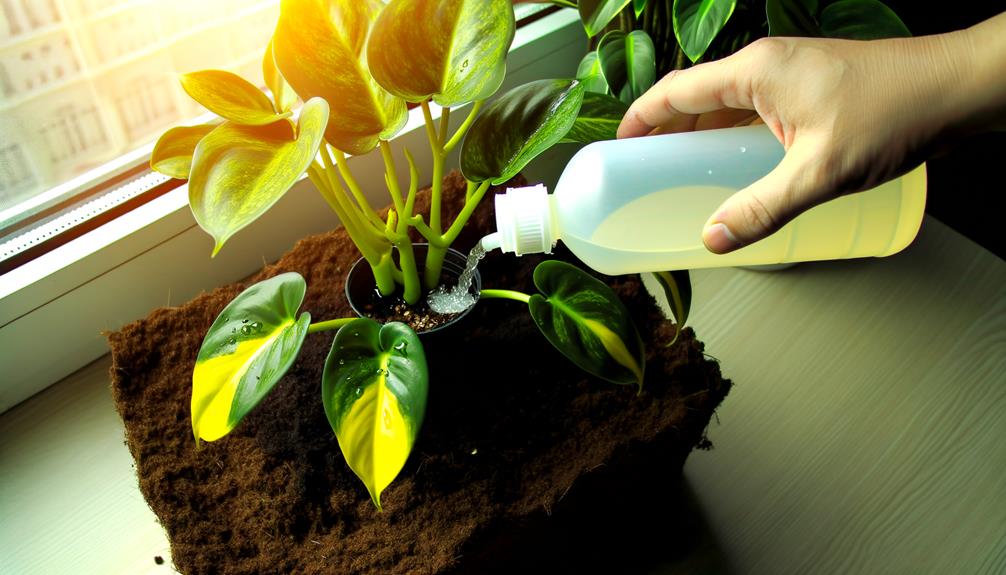
Ideal fertilization practices are crucial for sustaining the vigorous growth and vibrant foliage of Philodendron 'Yellow Congo'. A balanced, water-soluble fertilizer with an N-P-K ratio of 20-20-20 is recommended. Application should occur bi-monthly during the active growing season, typically from spring to early autumn.
Dilute the fertilizer to half the strength suggested on the packaging to prevent nutrient burn. Additionally, incorporating micronutrients such as magnesium (Mg), iron (Fe), and manganese (Mn) ensures peak chlorophyll production and photosynthetic efficiency.
Over-fertilization can lead to salt accumulation in the soil, negatively impacting root health. Hence, periodic leaching of the soil with distilled water is advised to flush out excess salts and maintain a favorable nutrient balance.
Common Issues
In addressing the common issues affecting Philodendron Yellow Congo, chlorosis, particularly the yellowing of leaves, often indicates nutrient deficiencies or environmental stressors.
Overwatering, leading to root hypoxia and subsequent root rot, is a crucial concern that can severely impact plant vitality.
Proper diagnosis and management of these issues are essential to maintaining prime health and vigor in Philodendron hederaceum var. oxycardium.
Yellowing Leaves Problem
Yellowing leaves in Philodendron Yellow Congo (Philodendron 'Congo') can be attributed to several factors, including nutrient deficiencies, improper watering, and pest infestations. Addressing yellowing leaves requires a systematic approach:
- Nutrient Deficiencies: Inadequate levels of essential nutrients such as nitrogen can result in chlorosis. Maintaining balanced fertilization with a complete, water-soluble fertilizer is essential.
- Improper Watering: Both under-watering and inconsistent watering schedules can stress the plant, leading to yellowing leaves. Ensuring consistent soil moisture is key.
- Pest Infestations: Common pests like spider mites and aphids can damage leaf tissues, causing discoloration. Regular inspection and appropriate pest management strategies are essential.
- Light Conditions: Insufficient light can hinder chlorophyll production, turning leaves yellow. Placing the plant in bright, indirect light ensures optimal photosynthesis.
Overwatering Effects
Overwatering Philodendron Yellow Congo (Philodendron 'Congo') can lead to root rot, a condition caused by fungal pathogens such as Pythium and Phytophthora. These pathogens thrive in waterlogged soil, leading to anoxic conditions detrimental to root health.
Symptoms of root rot include wilting, yellowing leaves, and stunted growth, as roots become unable to uptake essential nutrients. Diagnostically, affected roots appear brown, mushy, and emit a foul odor.
Preventative measures include ensuring proper drainage, using well-aerated potting mix, and allowing the soil to dry between waterings. If root rot is detected, immediate measures such as removing affected roots and repotting in fresh, sterile medium can mitigate further damage.
Fungicidal treatments may also be employed as a control strategy.
Propagation Methods
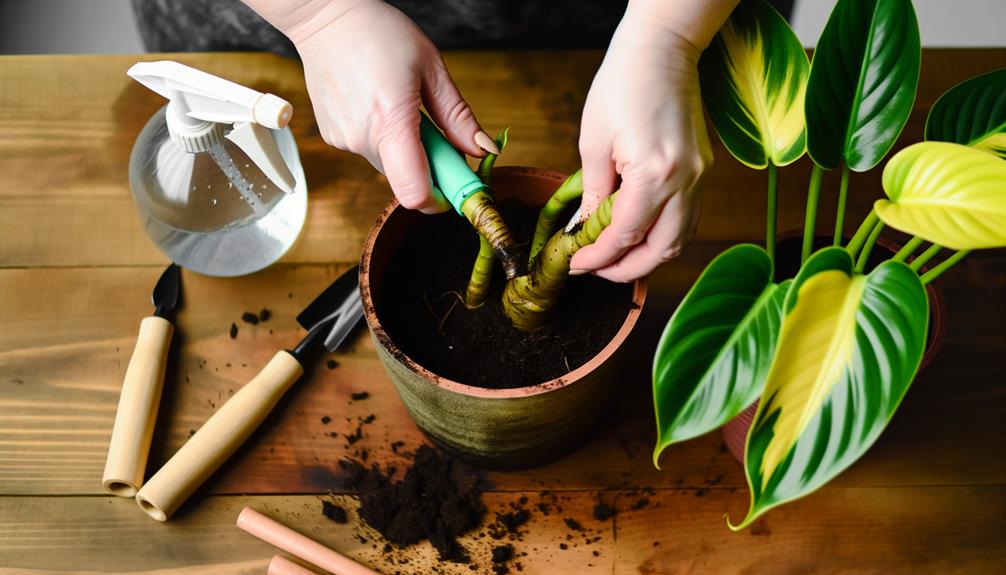
Propagation of Philodendron 'Yellow Congo' (Philodendron x 'Yellow Congo') can be effectively achieved through stem cuttings, ensuring a healthy and robust new plant. The process involves the following steps:
- Selection: Choose a healthy stem with at least one node and two leaves.
- Cutting: Use a sterilized, sharp knife to make a clean cut just below the node.
- Preparation: Remove lower leaves and dip the cut end in rooting hormone to promote root development.
- Planting: Insert the cutting into a well-draining substrate, such as a mix of peat and perlite, and maintain high humidity.
Proper care, including indirect light and consistent moisture, will facilitate successful propagation and growth of the new Philodendron 'Yellow Congo'.
Conclusion
In summation, the Philodendron 'Yellow Congo' displays unique botanical traits and requires specific care guidelines to uphold peak health. Emerging from tropical areas, its vivid yellow leaves and distinct growth habits make it a notable example in horticulture.
Appropriate light exposure, watering techniques, and humidity control are essential for its well-being. Fertilization, along with careful observation for common issues, guarantees strong growth.
Reproduction, mainly through stem cuttings, provides a way to maintain its striking beauty in cultivated settings.

